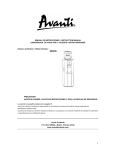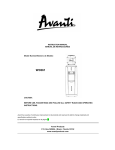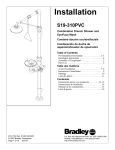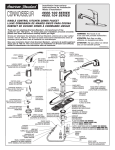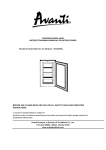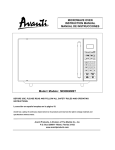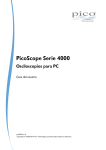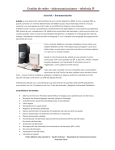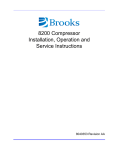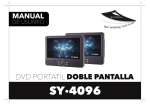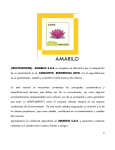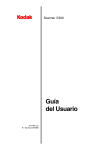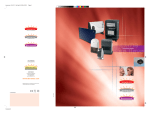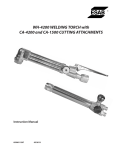Download This product is for domestic use only Use & care
Transcript
WINE COOLER REFRIGERADOR DE VINO Model/Modelo: PWC167MB This product is for domestic use only Use & care manual Important safeguards IMPORTANT SAFETY INSTRUCTIONS WARNING To reduce the risk of fire, electrical shock, or injury when using your Wine/Beverage Cooler, follow these basic precautions: Read all instructions before using the Wine/Beverage Cooler. DANGER or WARNING: Risk of child entrapment. Child entrapment and suffocation are not problems of the past. Junked or abandoned appliances are still dangerous . . . even if they will “just sit in the garage a few days”. Before you throw away your old Wine/Beverage Cooler: take off the doors. Leave the shelves in place so that children may not easily climb inside. Never allow children to operate, play with, or crawl inside the Wine/Beverage Cooler. Never clean Wine/Beverage Cooler parts with flammable fluids. The fumes can create a fire hazard or explosion. Do not store or use gasoline or any other flammable vapors and liquids in the vicinity of this or any other appliance. The fumes can create a fire hazard or explosion. -Save these instructionsINSTALLATION INSTRUCTIONS Before Using Your Wine/Beverage Cooler Remove the exterior and interior packing. Before connecting the Wine/Beverage Cooler to the power source, let it stand upright for approximately 2 hours. This will reduce the possibility of a malfunction in the cooling system from handling during transportation. Clean the interior surface with lukewarm water using a soft cloth. Installation of Your Wine/Beverage Cooler This appliance is designed to be free standing only, and should not be recessed or built-in (fully recessed). Place your Wine/Beverage Cooler on a floor that is strong enough to support it when it is fully loaded. To level your Wine/Beverage Cooler, adjust the adjustable leg at the bottom of the unit. Allow 5 inches of space between the back and sides of the unit, which allows the proper air circulation to cool the compressor. Locate the Wine/Beverage Cooler away from direct sunlight and sources of heat (stove, heater, radiator, etc.). Direct sunlight may affect the acrylic coating and heat sources may increase electrical consumption. Extreme cold ambient temperatures may also cause the unit not to perform properly. Avoid locating the unit in moist areas. Plug the Wine/Beverage Cooler into an exclusive, properly installed-grounded wall outlet. Do not under any circumstances cut or remove the third (ground) prong from the power cord. Any questions concerning power and/or grounding should be directed toward a certified electrician or an authorized Avanti Products service center. After plugging the appliance into a wall outlet, allow the unit to cool down for 2-3 hours before placing items in the compartment. Electrical Connection 2 Warning Improper use of the grounded plug can result in the risk of electrical shock. If the power cord is damaged, have it replaced by an authorized Products service center. This appliance should be properly grounded for your safety. The power cord of this appliance is equipped with a three-prong plug which mates with standard three prong wall outlets to minimize the possibility of electrical shock. Your wine cooler requires a grounded outlet. It is not recommended that the ground be bypassed to allow the unit to be plugged into a two-prong outlet. Use 3 pin plug only. Your wine cooler power rating is 115 Volts. 60HZ. Plug the appliance into an exclusive properly installed-grounded wall outlet. Do not under any circumstances cut or remove the third (ground) prong from the power cord. Any questions concerning power and/or grounding should be directed toward a certified electrician or an authorized Products service center. The cord should be secured behind the appliance and not left exposed or dangling to prevent accidental injury. Do not use an adapter plug with this appliance. Do not use an extension cord with this appliance. If the power cord is too short, have a qualified electrician or service technician install an outlet near the appliance. Temperature Setting Your wine cooler is factory set to provide your investment with an optimum environment for storage and longevity. Control Settting: Temperature Range: MAX: about 2℃-8℃ NORMAL: about 8℃-15℃ MIN: about 15℃-21℃ Your wine cooler should be plugged in and allowed to run for 24 hours before making any temperature adjustments. Wine stored in your wine cooler will be at temperature after 10 hours of storage. Note: Wine is alive. As such it reacts either positively or negatively to its environment. How it is treated will determine how fat or slow it will age and how it will turn out in the end. Essentially. Wine needs to be kept in a clean, dark place with good ventilation, where it can be stored vibration free at a constant temperature. Temperature is the most important factor and the factor that should be sought after above all others. The optimum temperature is 10℃12℃.However, any constant temperature of within 5℃-18℃ will do. More important than the actual temperature you will be able to achieve, is the degree and rapidity of temperature fluctuation the wine is subjected to. A slow change of temperature of ten or so degrees between winter and summer is not a problem. But this kind of fluctuation on a daily or weekly basis will cause damage to your wines and age them prematurely. You will notice damage of this nature from the sticky deposit that often forms around the capsule. In time, as the wine 3 expands and contracts, it will damage the integrity of the cork. When this happens, minute quantities of wine may make its way alongside the cork possibly even allowing oxygen to seep back in. Wines kept at too high a temperature will age faster than wines kept at cold temperature. Theoretically, wines kept at 15℃ will age twice as fast as those kept at 12℃. At 12℃ wines will age so slowly-with ultimately greater complexity-that you will never have to worry about them.This is not to say the colder the better. Wine that is stored too cold can develop deposits or other suspensions in the wine. Finally, keep in mind that white wines are affected far more by temperature problems than red wines. Trouble Shooting Trouble Q: Your wine cooler is not getting cold enough, no matter what it is set at Remedial Measures A: Make sure that the unit is away from direct sunlight and heat sources. Check the vent and clean if possible. Has the unit been running for 24 hours? Contact Customer Service. Q: The light does not come A: Check the light bulb. on. Make sure the electrical outlet is providing Consistent power. Q: The light will not go out. A: Make sure the door is closed. Contact Customer Service. Q: The humidity level is too A: Has the unit been running for 24 hours? low. Make sure your unit is away from sunlight and Heat sources. Make sure the door is closed. Place a cup of water inside the unit. Contact Customer Service. Glass Door From time to time, depending on the external temperature and humidity level, some condensation may appear on the glass door. This phenomenon has no effect on the wine and will disappear when the difference between the external and internal temperature is reduced. General Information For Wine Storage 1. For a wine lover, a cooler is a necessity. Fine wines are worth paying extra for only if you can store and eventually serve them in good condition. The principle s behind storing wine are not complex, difficult to understand or necessarily difficult to achieve. And if you can’t achieve them all, some of them are better than none. Let’s begin with the ideal. From here, you can then try to approach the ideal as close as you are able. You are looking to achieve balance and consistency. 2. Maintaining the correct environment is essential if you are going to store your wines for an extended period of time. The desirable environment is a temperature range of 12℃4 13℃ and between 55% to 75% humidity. To maintain this environment you must isolate your cellar from any conditions that would compromise these desired ranges. 3. In the process of cooling a room, air-conditioners and refrigerator driers out the air. They are designed to perform properly in the 12℃-13℃ and 55% to 75% humidity range. Because of this, it is necessary to buy refrigeration units designed specifically for wine cooler if you want to maintain the proper environment. 4. Moderate humidity is important so as to keep the corks in good resilient condition and there by preventing them from shrinking. A relative humidity of 50%-80% is the acceptable range, but about 70% is recommended. Excessive humidity will not harm the wine but will cause the corks to dry out, lose their elasticity and there by allow air to get into the bottle. 5. Constant vibration form machinery or a nearby road disturbs red wine’s sediment and can be harmful to all wine. This is not commonly a problem in the average home as dangerous extremes are rare and obvious. It should be remembered that excessive sound creates vibrations that may be harmful as well. 6. Wines should be stored in such a way that you don’t have to move them around to get at a particular bottle. Once a wine is laid down, it should stay there until it is opened. 7. The space should be free from smells and debris. Extraneous smells can enter through the cork and contaminate the wine. Proper ventilation will help with this problem and keep the cellar from giving the wine a musty taste. Finally debris that could be a home to insects that might infect the corks-untreated wood, food should be removed. Never store fruits, vegetables, cheese or any food that is capable of fermenting. 8. Table wine is stored horizontally so that the wine stays in contact with the cork. This keeps the cork moist there by preventing air from entering the wine. Fortified wines other than port, are stored standing. If bottles are stored with the labels up, it will be easier to see the deposit of sediment that forms on the opposite side of the bottle when it comes time to open it. warning 1) WARNING – Keep ventilation openings, in the appliance enclosure or in the built-in structure, clear of obstruction. 2) WARNING – Do not use mechanical devices or other means to accelerate the defrosting process, other than those recommended by the manufacturer. 3) WARNING – Do not damage the refrigerant circuit. 4) WARNING – Do not use electrical appliances inside the food storage compartments of the appliance, unless they are of the type recommended by the manufacturer; 5) The appliance has to be unplugged after use and before carrying out user maintenance on the appliance. 6) This appliance is not intended for use by persons (including children) with reduced physical, sensory or mental capabilities, or lack of experience and knowledge, unless they have been given supervision or instruction concerning use of the appliance by a person responsible for their safety. 5 7) 8) Children should be supervised to ensure that they do not play with the appliance. If the supply cord is damaged, it must be replaced by the manufacturer, its service agent or similarly qualified persons in order to avoid a hazard. 9) Please abandon the refrigerator according to local regulators for it use flammable blowing gas and refrigerant. CARE AND MAINTENANCE Cleaning Your Wine/Beverage Cooler Unplug the Wine/Beverage Cooler, and remove all items including shelves and rack. Wash the inside surfaces with a warm water and baking soda solution. The solution should be about 2 tablespoons of baking soda to a quart of water. Wash the shelves and rack with a mild detergent solution. The outside of the Wine/Beverage Cooler should be cleaned with mild detergent and warm water. Wring excess water out of the sponge or cloth when cleaning area of the controls, or any electrical parts. Wash the outside cabinet with warm water and mild liquid detergent. Rinse well and wipe dry with a clean soft cloth. Power Failure Most power failures are corrected within a few hours and should not affect the temperature of your Wine/Beverage Cooler if you minimize the number of times the door is opened. If the power is going to be off for a longer period of time, you need to take the proper steps to protect your contents. Vacation Time Short vacations: Leave the Wine/Beverage Cooler operating during vacations of less than three weeks. Long vacations: If the appliance will not be used for several months, remove all items and unplug the power cord. Clean and dry the interior thoroughly. To prevent odor and mold growth, leave the door open slightly: blocking it open if necessary. Moving Your Wine/Beverage Cooler Remove all items. Securely tape down all loose items (shelves and basket) inside your Wine/Beverage Cooler. Turn the adjustable foot up to the base to avoid damage. Tape the door shut. Be sure the Wine/Beverage Cooler stays secure in the upright position during transportation. Also protect outside of Wine/Beverage Cooler with a blanket, or similar item. Energy Saving Tips The Wine/Beverage Cooler should be located in the coolest area of the room, away from heat producing appliances, and out of the direct sunlight. Try not to open the door too often, especially when the weather is wet or hot. Once you open the door, mind to close it as soon as possible. This appliance is intended to be used exclusively for the storage wine. Every now and then check if the appliance is sufficiently ventilated (adequate air circulation behind the appliance). For wine storage appliances, please arrange the temperature following the instruction: SPARKLE: 5-7 °C, WHITE:8-12°C, RED:13-18°C. Always consider instructions stated in sections Positioning and Energy Saving Tips, otherwise the energy consumption is substantially higher. 6 PROBLEMS WITH YOUR WINE/BEVERAGE COOLER? You can solve many common Wine/Beverage Cooler problems easily, saving you the cost of a possible service call. Try the suggestions below to see if you can solve the problem before calling the servicer. TROUBLESHOOTING GUIDE PROBLEM Wine/Beverage Cooler does not operate. POSSIBLE CAUSE Not plugged in. The circuit breaker tripped or a blown fuse. Check the temperature control setting. External environment may require a higher setting. The door is opened too often. The door is not closed completely. The door gasket does not seal properly. The Wine/Beverage Cooler does not have the correct clearances. The room temperature is hotter than normal. The door is opened too often. The door is not closed completely. The temperature control is not set correctly. The door gasket does not seal properly. The Wine/Beverage Cooler does not have the correct clearances. Check to assure that the Wine/Beverage Cooler is level. The rattling noise may come from the flow of the refrigerant, which is normal. As each cycle ends, you may hear gurgling sounds caused by the flow of refrigerant in your Wine/Beverage Cooler. Contraction and expansion of the inside walls may cause popping and crackling noises. The Wine/Beverage Cooler is not level. The Wine/Beverage Cooler is not level. The door was reversed and not properly installed. The gasket is dirty. The shelves are out of position. Wine/Beverage Cooler is not cold enough. Turns on and off frequently. Vibrations. The Wine/Beverage Cooler seems to make too much noise. The door will not close properly. 7 PRECAUCION: El producto no esta preparado para que sea usado por niños o personas discapacitadas sin supervisión. Niños deben estar bajo supervisión para asegurarse de que no jueguen con el producto. INSTALACION Asegúrese de que el voltaje marque del producto corresponda respecto al voltaje de su casa. La heladera esta diseñada para operar en cuartos con temperatura normal. Colóquelo lejos de cualquier fuente de calor como una caldera, hornos y calentadores, puede reducir la eficiencia del enfriamiento del refrigerador. También es recomendable no instalar el aparato en lugares sin calefacción como garajes o dependencias, ya que estos pueden mermar el funcionamiento del refrigerador en invierno. El refrigerador requiere espacio alrededor de la cubierta para una refrigeración eficiente y un buen funcionamiento. Esta diseñado para auto sostenerse. El refrigerador debe estar instalado en una superficie firme, plana y nivelada para que trabaje de forma silenciosa y eficiente. Si es necesario, gire el pie ajustable para nivelar el aparato. Enchufe el refrigerador a una toma de corriente cercano y enciéndalo. Un zumbido del compresor indicaráque el refrigerador esta en funcionamiento. CONEXIONES ELECTRICAS Su refrigerador de vino requiere una toma de tierra. No la elimine colocando un adaptador o reemplazándola por una ficha de dos clavijas. Utilice el enchufe de 3 pines solamente. La potencia del refrigerador es de 115 volts. 60HZ Por favor, permita que únicamente un profesional entrenado trabaje sobre su refrigerador. AJUSTE DE LA TEMPERATURA Su refrigerador de vino se ajusta en fábrica para proporcionar su inversión con un entorno óptimo para el almacenamiento y larga duración. Control de configuración: Rango de temperatura. MAX: 7ºC – 10ºC NORMAL: 11ºC - 15ºC MIN: 16ºC – 18ºC Su refrigerador de vino debe estar enchufado y dejarlo funcionar durante 24hs antes de hacer cualquier ajuste de temperatura. Todo vino que guarde en el refrigerador estaráa temperatura después de 10 horas de almacenamiento. NOTA: el vino esta vivo. Como tal, reacciona de manera positiva o negativa a su entorno. ¿Cómo se trata de determinar la edad y cómo va a resultar al final? 9 En esencia. El vino debe mantenerse en un lugar limpio, oscuro y con buena ventilación, donde se pueda almacenar sin vibraciones, a una temperatura constante. La temperatura es el factor más importante y el factor que debe ser buscado por encima de todos los demás. La temperatura óptima es de 10ºC – 12ºC. Sin embargo, cualquier temperatura constante de 5ºC - 18ºC servirá. Más importante que la temperatura real que usted serácapaz de lograr, es el grado y la rapidez de las fluctuaciones de temperatura que se somete al vino. Un lento cambio de la temperatura de una decena de grados entre el invierno y el verano no es un problema. Pero este tipo de fluctuaciones en torno a una base diaria o semanal puede causar daños en sus vinos y aumentar la edad antes de tiempo. Usted se darácuenta de los años de esta naturaleza desde el depósito pegajoso que a menudo se forma alrededor de la cápsula. Con el tiempo, como el vino se expande y contrae, se dañarála integridad del corcho. Cuando esto ocurre, pequeñas cantidades de vino pueden hacer caminito junto al corcho, posiblemente, incluso provocando que el oxí geno se filtre. Si los vinos se mantienen a temperaturas demasiado altas, provocaráel envejecimiento más rápido que si se los mantiene en temperatura frí a. Teóricamente, los vinos que se mantienen a los 15ºC, envejecen el doble de rápido que los que se conservan a los 12ºC. A los 12ºC los vinos envejecen tan lentamente -en última instancia y con una mayor complejidad- que usted no tendráque preocuparse por ellos. Esto no quiere decir que cuanto más frí a mejor. El vino que es almacenado demasiado frí o puede desarrollar depósitos u otras suspensiones en el vino. Por ultimo, tenga en cuenta que los vinos blancos se ven afectados mucho más por problemas de temperatura que los vinos tintos. SOLUCION DE PROBLEMAS P: su refrigerador no esta enfriando lo suficiente, sin importar cuánto se lo programe R: Asegúrese de que la unidad este fuera de la luz solar y de elementos calientes. Cheque la ventilación y si es necesario límpiela ¿ha estado el refrigerado conectado las 24hs? Contáctese con el Servicio al Cliente P: las luces no se prenden R: Revise las bombillas Asegúrese de que la salida de electricidad esta dando energía constante. P: Las luces no se apagan R: Asegúrese de que las puertas estén cerradas. Contáctese con Servicio al Cliente. P: El nivel de humedad es muy bajo R: ¿ha estado el refrigerador prendido por 24hs? Asegúrese de que el producto este lejos de la luz solar y de elementos calientes. Asegúrese de que la puerta este bien cerrada. Coloque un vaso de agua dentro del refrigerador. Contáctese con Servicio al Cliente. PUERTA DE VIDRIO De vez en cuando, dependiendo de la temperatura externa y el nivel de humedad, puede aparecer en la puerta de vidrio el efecto de condensación. Este fenómeno no tiene efecto sobre el vino y desaparecerácuado la diferencia entre la temperatura exterior y la del interior se reduzca. INFORMACION GENERAL DEL ALMACENAMIENTO DE VINOS 10 1. para un amante del vino, un refrigerador es una necesidad. Los vinos finos vale la pena pagar extra si se lo puede almacenar y, eventualmente, servir en buenas condiciones. Los principios para almacenar el vino no son complejos, ni difíciles de entender ni de lograr. Y si usted no puede alcanzar a todos, algunos de ellos son mejores que nada. Comencemos con la idea, desde aquí , usted puede entonces tratar de acercarnos la idea. Usted esta en la búsqueda del equilibrio y la coherencia. 2. Mantener el ambiente correcto es esencial si usted piensa almacenar sus vinos durante un perí odo prolongado. El rango de temperatura ambiental ideal es de 12ºC-13ºC y entre 55% a 75% de humedad. 3. en el proceso de enfriamiento de una habitación, aire acondicionado y refrigeradores de aire, están diseñados para mantener de manera adecuada el rango 12ºC-13ºC y de 55% A 75% de humedad. Debido a esto, es necesario comprar unidades de refrigeración diseñado especí ficamente para el refrigerador de vino, si quiere mantener el ambiente apropiado. 4. Moderar la humedad es importante para mantener los corchos en buena condición y resistentes para impedir que se estrechen. Una humedad relativa del 50% - 80% es el rango aceptable, pero recomendado alrededor del 70%. El exceso de humedad no dañaráel vino, pero haráque el corcho se seque, pierda elasticidad y provocaráque el aire entre en la botella. 5. vibraciones constantes o una carretera cercana perturba los sedimentos del vino tinto y pueden ser perjudiciales para todos sus vinos. Esto no es un problema común en el hogar. Hay que recordar que el sonido excesivo crea vibraciones que pueden ser perjudiciales. 6. los vinos deben ser almacenados de tal manera que usted no tenga que moverse para llegar a una botella en particular. Una vez que un vino se coloca dentro, debe permanecer ahíhasta su consumo. 7. el espacio debe estar libre de olores y desechos. Olores extraños pueden entrar a través del corcho y contaminar el vino. Un poco de ventilación ayudarácon este problema y mantendrála bodega húmeda. Por último, residuo que pudiera ser hogar para los insectos que pueden infectar a la madera sin tratarcorchos, los alimentos deben ser eliminados. Nunca almacenar frutas, verduras, queso o cualquier alimento que fuere capaz de fermentar. 8. el vino de mesa es almacenado horizontalmente permaneciendo el vino en contacto con el corcho. Esto mantiene el corcho húmedo e impide que entre el aire en la botella. Vinos de licor, se almacenan de pie. Si se almacenan botellas con las etiquetas para arriba, serámás fácil ver el depósito de sedimentos que se forma en el lado opuesto de la botella cuando llegue el momento de abrirlo. 11 Manual de uso y cuidado Precauciones importantes Éste producto es para uso doméstico únicamente











